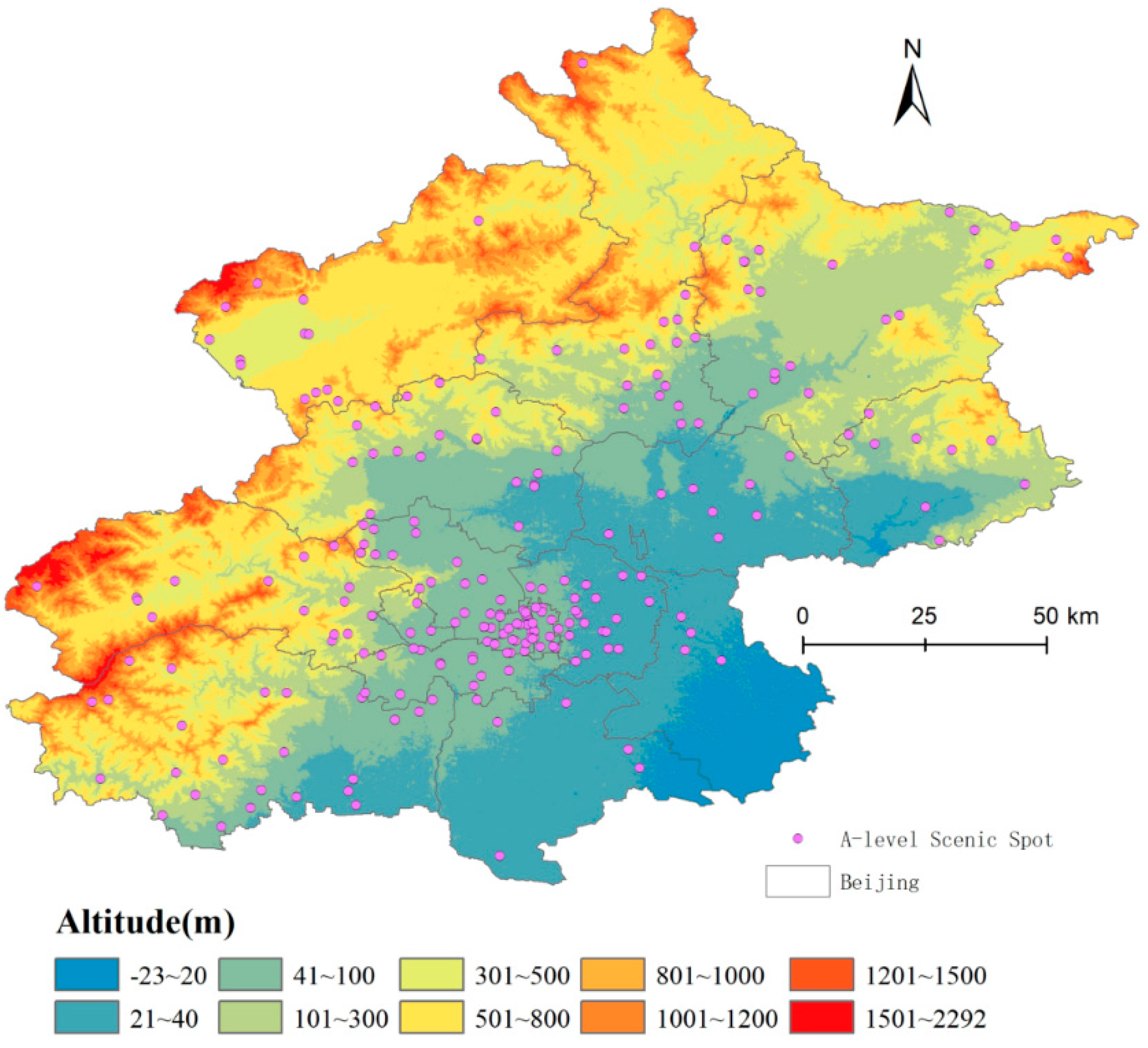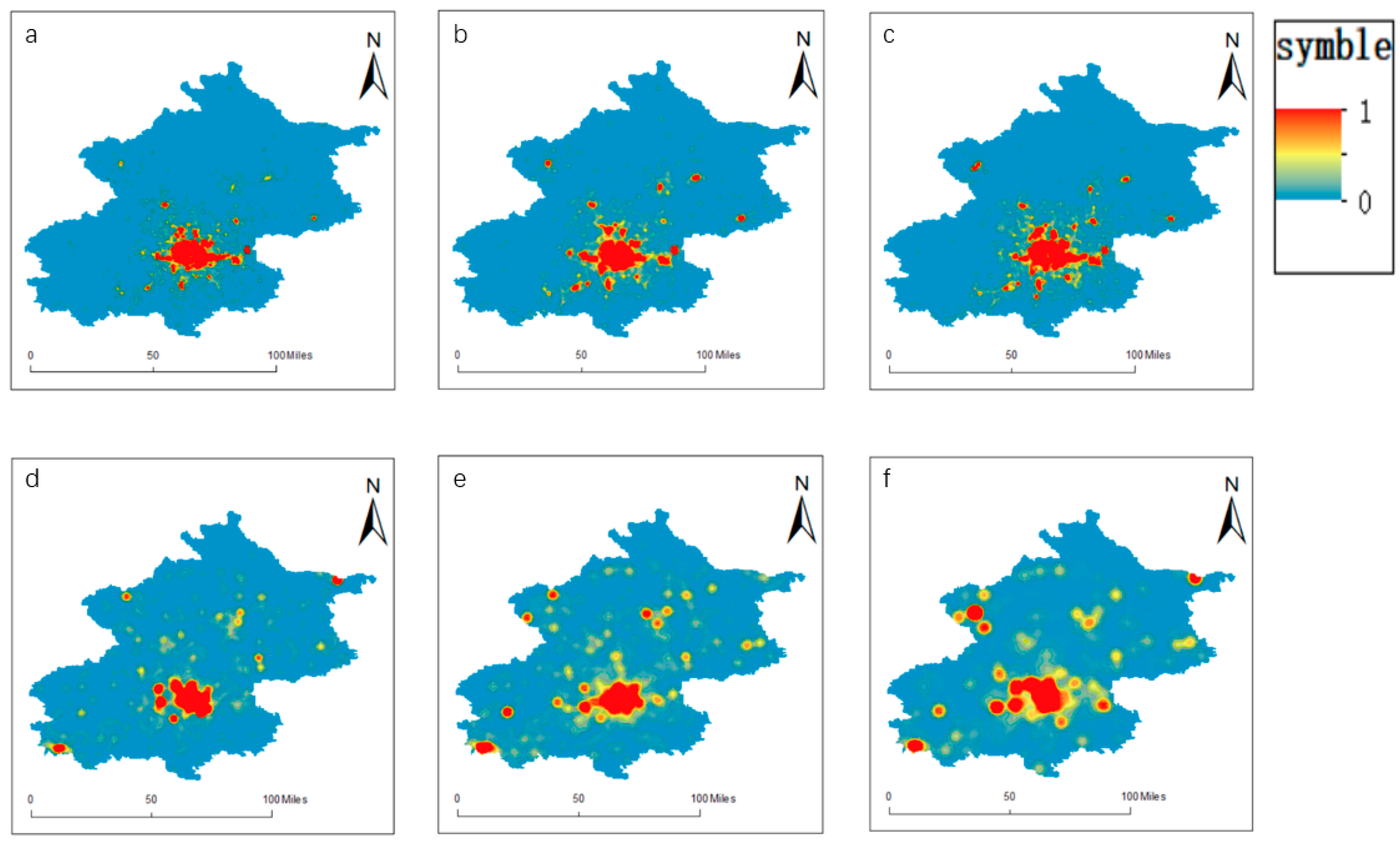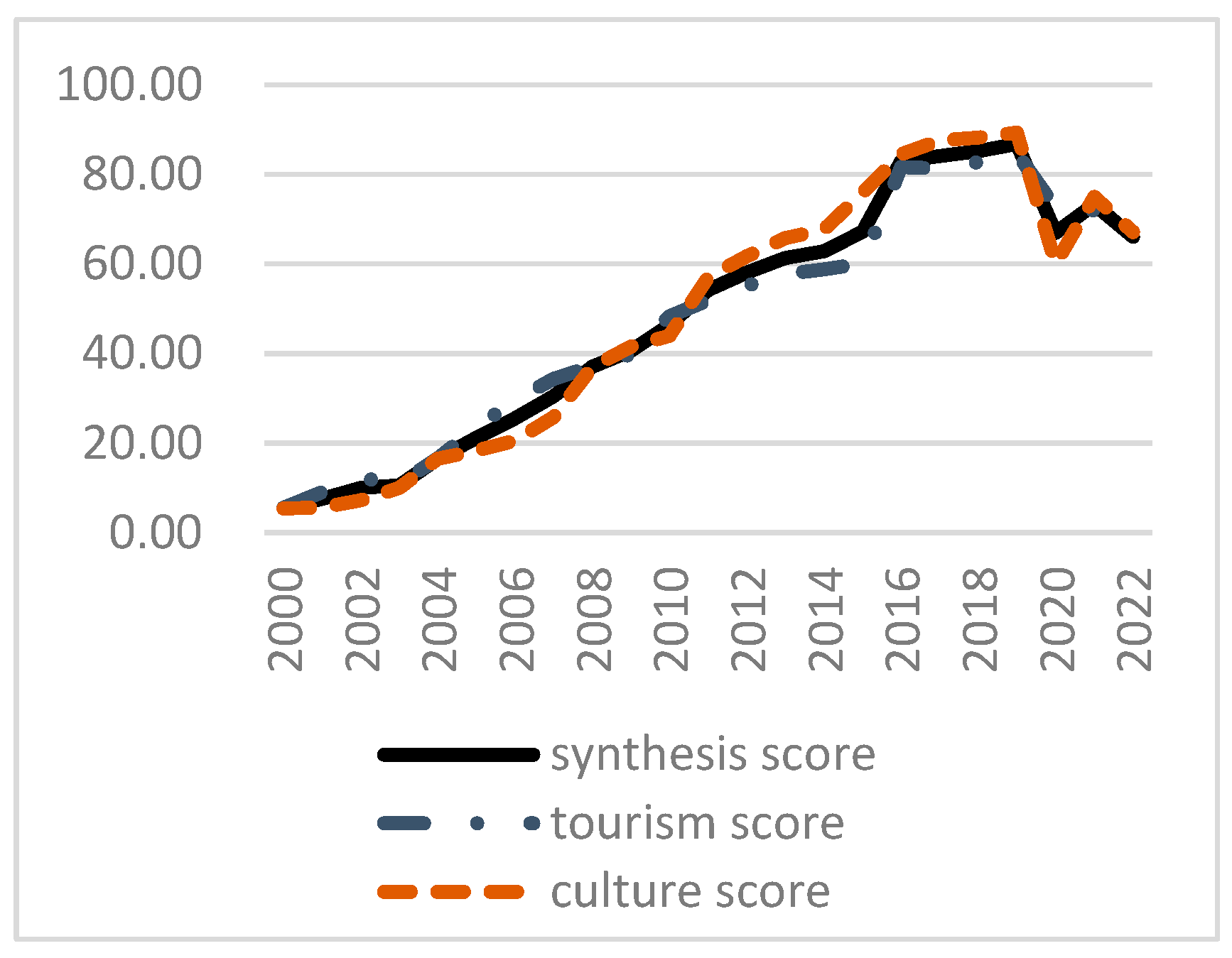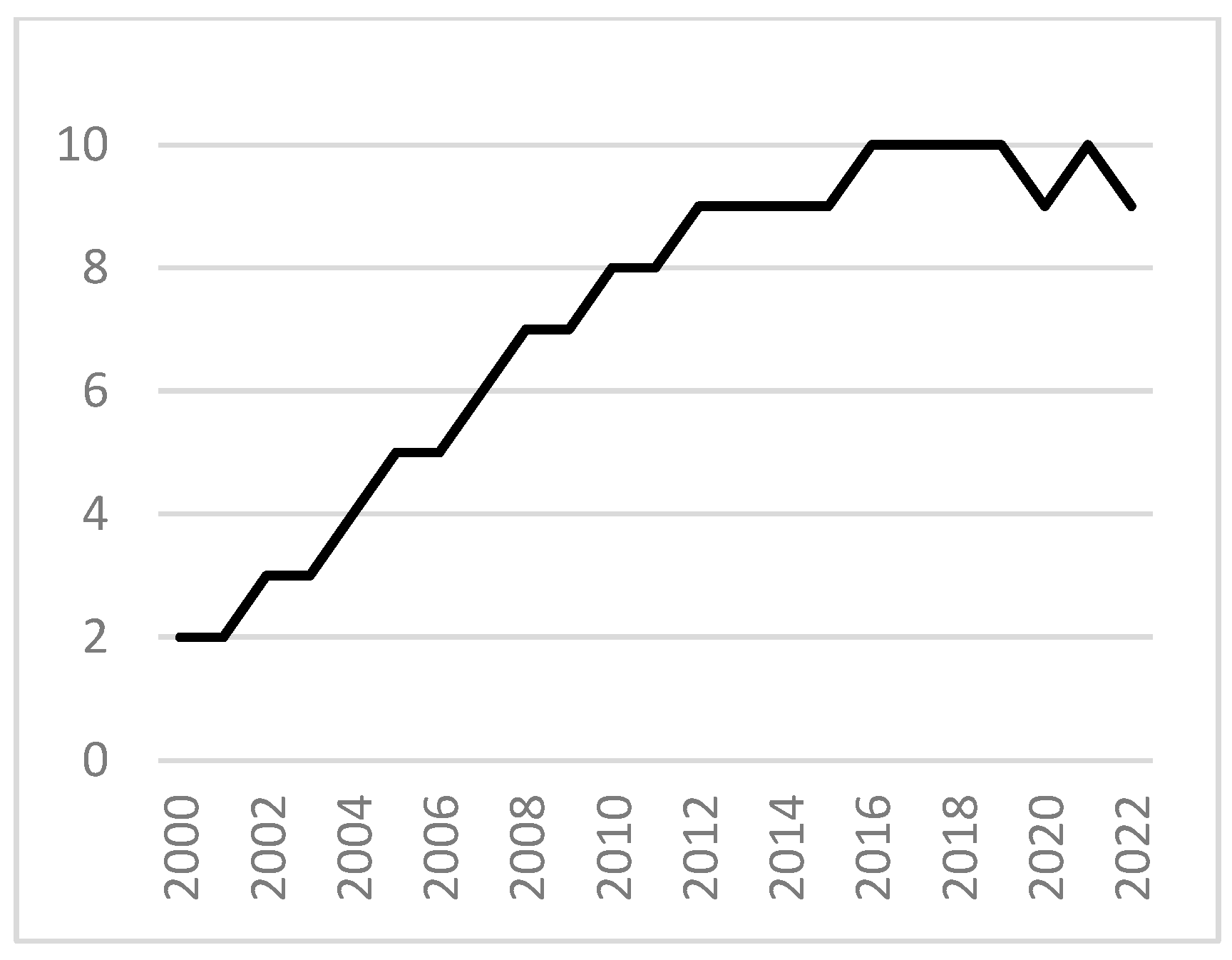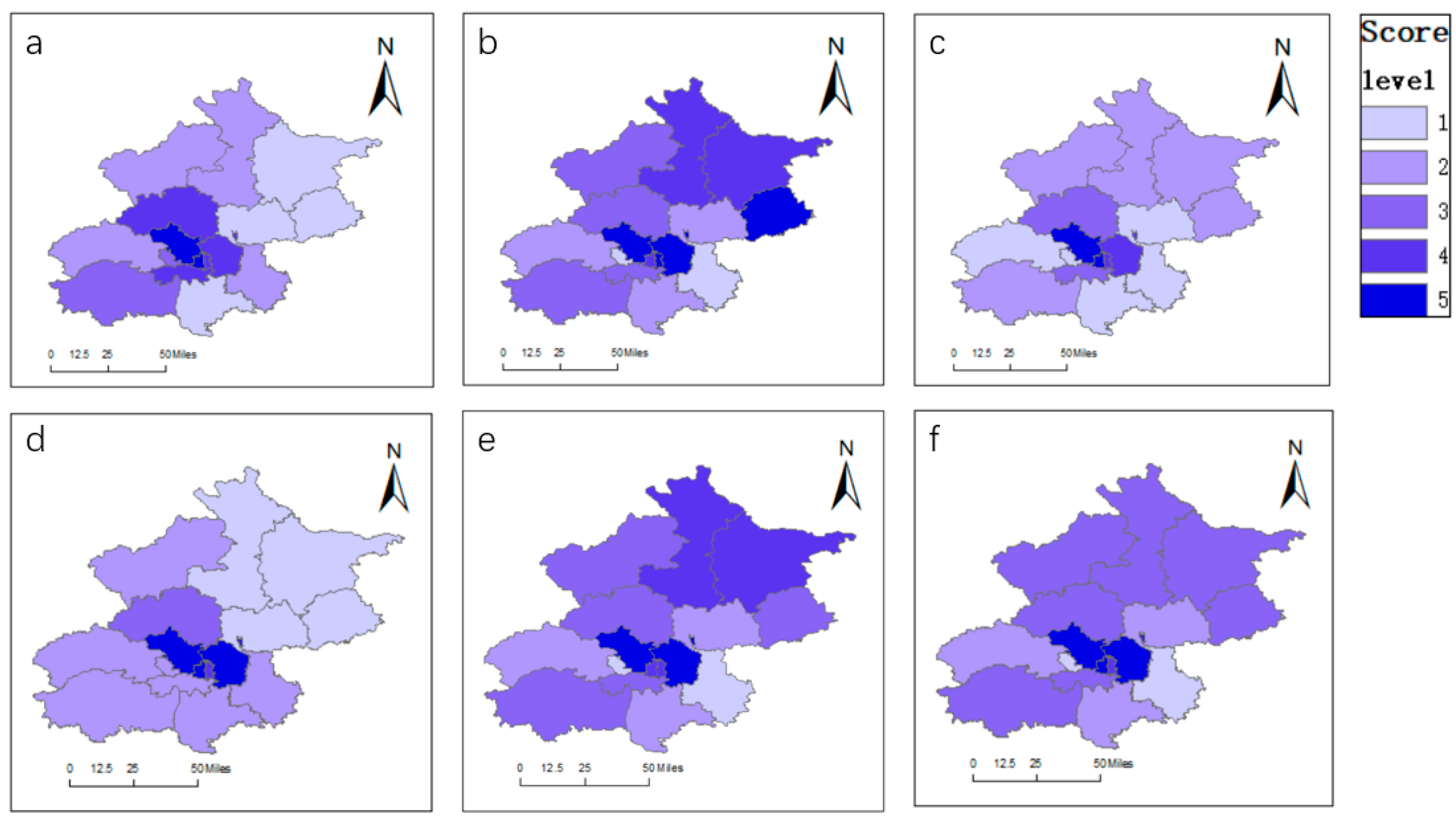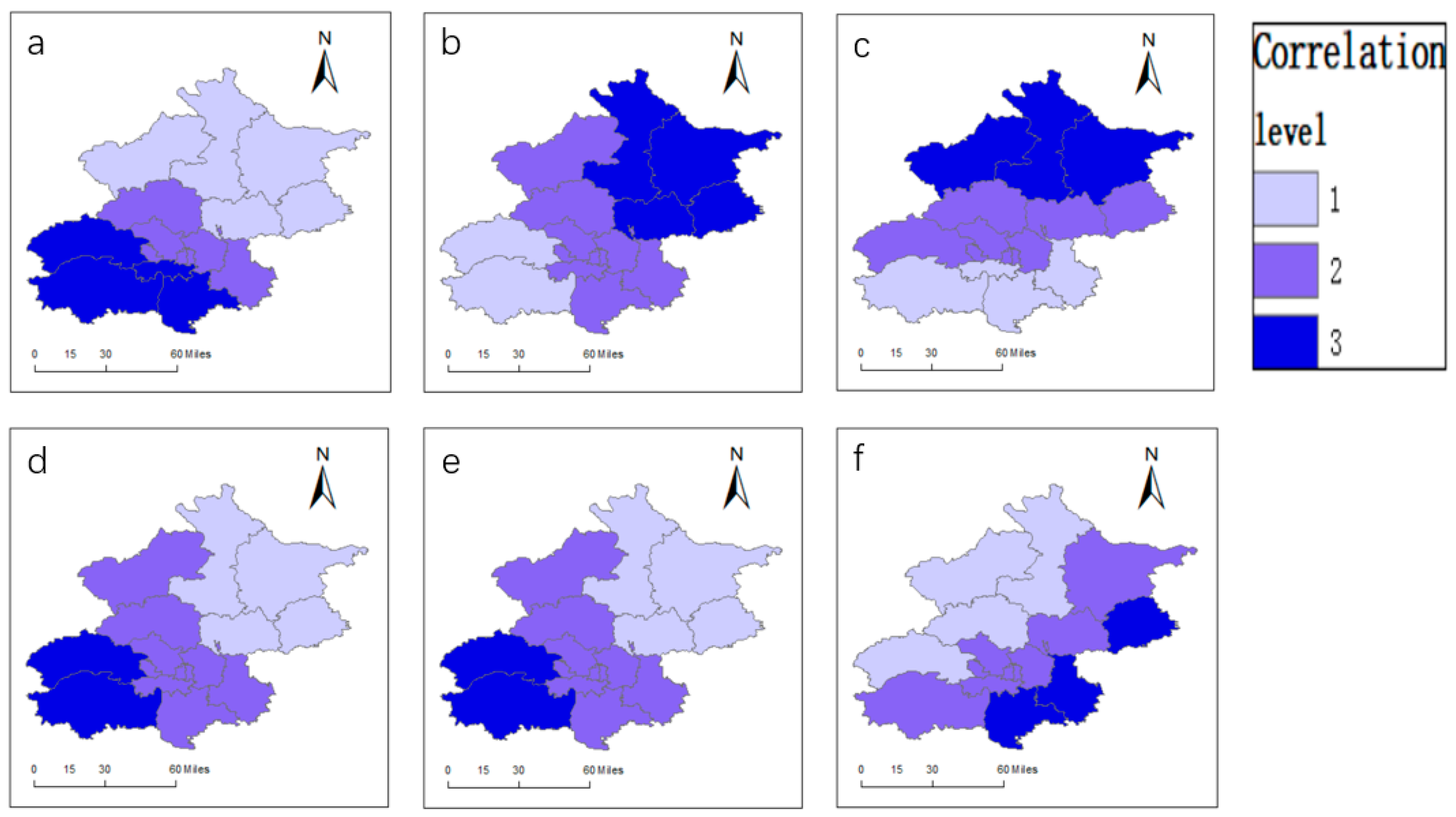1. Introduction
The positive effect of the tourism industry on economic growth has been extensively demonstrated [
1,
2,
3]. In recent years, cultural tourism has become the main growth area of the tourism industry, and thus, researchers are paying increasing attention to cultural tourism [
4,
5]. Therefore, the Chinese government has introduced a series of policies promoting the integration of the cultural and tourism industries. Some scholars have analyzed the level of integration of the two industries [
6,
7,
8] but have ignored a type of important cultural resource beyond the cultural industry [
4]. Cultural tourism is essentially a specialized market segment within the tourism industry [
9,
10]. The integration of culture and tourism is mainly reflected in three aspects: resource endowment, infrastructure, and output. Resource endowment is the foundation of the integration of culture and tourism, and infrastructure is the guarantee of the integration of culture and tourism, and it is the efforts made by regional subjects to realize the development of cultural tourism. In terms of culture, it is represented by the number of cultural units and universities, and in terms of tourism, it is represented by the environmental quality and traffic conditions. The output is the embodiment of the integration effect of culture and tourism, which is represented by the number of visitors to cultural units in culture and tourism income in tourism. While some scholars have considered the integration of cultural resources and the tourism industry, they have failed to consider the impact of infrastructure and cultural outputs on the degree of integration [
11]. Attempts to measure the effectiveness of cultural tourism integration in the absence of cultural infrastructure and its outputs are likely to result in misleading conclusions. Thus, there is a lack of a systematic method for measuring the degree of integration of culture and tourism.
Given the trend toward an increasingly diversified and fragmented development of the cultural tourism industry [
6], the forms of cultural and tourism integration are becoming more and more abundant, and the number of cultural tourism for intangible cultural heritage is also increasing [
4,
12]. On the one hand, studies on the development of traditional cultural resources, such as metropolitan suburbs [
13], traditional villages [
14], tea culture [
15,
16], and religious culture [
17], have begun to attract increasing attention. On the other hand, studies on emerging cultural resources, such as performing culture [
18], food culture [
19], medical culture [
20], and creative culture [
4], are also gaining increasing attention.
Taking Jiangsu Province as the research area, Weili Shen et al. built a coupling sensitivity and perception model of the culture and tourism system and proposed that, with the passage of time, the comprehensive development level of the two systems is constantly improving and pointed out that the spatial distribution of the cultural tourism system in Jiangsu Province has obvious spatial dependence and spillover [
11]. Guoqiang Xiong et al. used the gray measurement model to study the complementarity of the integration and development of the cultural industry and the tourism industry and believed that the level of economic integration in China was low, and the overall trend was slowly rising [
21]. S. Vujovi et al., taking Vojvodina as a sample, studied the economic effects of cultural heritage on the development environment of agri-tourism and concluded that cultural heritage has an obvious promoting effect on tourism, especially agri-tourism [
22].
Measuring the degree of culture and tourism integration has the potential to contribute to the sustainable development of global cultural tourism resources and promote high-quality economic development. Thus, numerous scholars have attempted to measure it using the coupling coordination model [
23,
24,
25]. The basis of the coupling coordination model is the establishment of an evaluation index based on the focus of the study and data availability. The evaluation index system is usually set as three levels, and the first level index is divided into two dimensions: culture and tourism. Regarding the secondary indicators, various dimensions of the evaluation index are constructed from different perspectives, such as the integration subject, integration resources, and integration benefits [
23,
24,
25]. Most existing coupling coordination models have been combined with the analytic hierarchy process (AHP) [
26,
27], which is often limited by the ability and subjectivity of the researchers. Compared with the AHP, the entropy method is relatively objective. When combined with spatial analysis methods, such as the kernel density method and the geographic weighted model method, this can render the coupling coordination model more intuitive and spatially visualizable [
28,
29].
Moreover, geographic information system (GIS) technology can be applied to the integration of multiple disciplines and innovative research methods. For instance, we used spatialization and interdisciplinary methods to complete the mapping of priority global wetland conservation areas [
30] and track the sustainable tourism development process in 13 cities in the Beijing–Tianjin–Hebei urban agglomeration [
31]. Based on the spatialization perspective, in this study, we propose a spatial quantification method that combines the entropy method, the spatial coupling coordination model, and the geographic weighting model. We explore the effectiveness of and factors influencing the integration of culture and tourism in various districts and counties of Beijing.
As the center of politics, culture, international exchanges, and scientific and technological innovation in China, Beijing has abundant resources of ancient capital culture, Red culture, folk culture, and innovative culture, which is a representative sample for studying the integration of culture and tourism. Therefore, this paper takes Beijing as an example to conduct an empirical study on the quantitative methods of cultural and tourism integration.
2. Materials and Methodology
2.1. Research Area
In this study, we used Beijing as the research area. The capital of the People’s Republic of China, Beijing is located in the north of China, adjacent to Tianjin to the east and Hebei Province to the west. Beijing governs 16 districts covering a total area of 16,410.54 square kilometers. The western, northern, and northeastern regions are surrounded by mountains, while the southeastern region is largely a plain that slopes gently toward the Bohai Sea. As of the end of 2023, there were 216 A-level or above scenic spots in Beijing (
Figure 1).
2.2. Data Sources
In this study, we mainly used socioeconomic, intangible cultural heritage, cultural relic, and related spatial vector data. Socioeconomic data at the municipal level were obtained from the 2011–2023 editions of the Beijing Statistical Yearbook, while those at the district level were obtained from the 2014 and 2021 editions of the Beijing Regional Statistical Yearbook. Additional data were obtained from the China Intangible Cultural Heritage Network’s digital museum, the official website of the Beijing Municipal Bureau of Cultural Heritage, and Gaode Maps. All of these data were spatially vectorized.
2.3. Methods
To enable us to systematically analyze the cultural and tourism endowments of the research area, we used the kernel density analysis tool in Arcgis10.8 software to obtain the spatial distribution characteristics of Beijing’s cultural and tourism endowments. Using the dimensions of culture and tourism, we constructed an evaluation index to measure the degree of culture and tourism integration from the perspectives of resource endowment, infrastructure, and outputs. We also developed a method of categorizing the level of integration by constructing a culture and tourism spatial coupling coordination model based on the dimensions of coupling and coordination. Finally, a geographically weighted model was used to analyze the factors influencing the level of integration. This study contributes to the literature by proposing a more comprehensive method of measuring the degree of integration and quantitatively analyzing the factors influencing the degree of integration of culture and tourism.
Nuclear density can directly reflect the distribution characteristics of the observation indicators of the cultural system and the tourism system in each district of Beijing. By observing the nuclear density map, we can directly judge the integration of the cultural system and the tourism system in each district of Beijing. However, nuclear density analysis is limited to the qualitative discussion of fusion degree and cannot perform quantitative analysis. On this basis, by constructing the evaluation index system and using the coupling coordination degree analysis method to analyze the mutual relationship and coordination between the cultural system and the tourism system, the quantitative analysis of the cultural system and the tourism system can be realized, and the shortcomings of the lagging system in the integration process of the cultural system and the tourism system in various districts of Beijing can be further revealed. However, although the coupling coordination degree analysis can compare the integration degree of different regions in Beijing and can also analyze the reasons for the differences to a certain extent, it cannot effectively distinguish the heterogeneity of different districts in Beijing. However, the geographically weighted regression model can solve this problem, which will be crucial for the analysis of the integration degree of culture and tourism and its influencing factors.
For the construction of the evaluation index system, this paper believes that resource endowment, infrastructure, and output are the main contents of the integration of culture and tourism, while management, technology, and the economic development level are regarded as the influencing factors of the integration of culture and tourism. Cultural resources and tourism resources are interdependent, and the construction of technical facilities of culture and tourism can also promote each other. The output is the key window to examine the integration degree of cultural tourism. On the one hand, it can show the development degree of cultural tourism, and on the other hand, it can clearly observe the shortcomings of cultural tourism. It is helpful for policymakers to formulate corresponding measures in a timely manner.
2.3.1. Kernel Density Calculation
In order to show the development of the cultural tourism resource endowment in Beijing and combine it with the availability of vector data, this paper analyzes the cultural tourism resources of Beijing in 2015, 2018, and 2021, respectively, based on the vector data of cultural resources and tourism resources. The more resources there are in an area, the higher the estimated kernel density [
32]. The basic calculation can be expressed as
where
n represents the number of sample points,
h represents the search radius,
represents the distance from the center point of the grid to a specific point, and
k represents the ratio of the distance from the center point of the grid to a specific point in the search radius.
2.3.2. Spatial Coupling Coordination Measurement Model
- (1)
Construction of an evaluation index
In this study, we constructed an evaluation index measuring the degree of integration of culture and tourism in three dimensions: resource endowment, infrastructure, and outputs. Based on data availability at the municipal and district levels in Beijing, we constructed evaluation indexes measuring the degree of culture and tourism integration at both the municipal and district levels (see
Table 1 and
Table 2, respectively). The entropy method was then used to allocate weights to the various indicators.
The first step is data standardization. The original data were standardized to overcome the differences in magnitude and dimension among the indicators. The indicators used in this study were all positive, and thus, the standardization formula was
where
i represents the region,
j represents the indicator, and
t represents time.
The weight of indicator
j in region
i in year
t is denoted by
, from which a spatial weight matrix can be presented as
where
The second step is computational information entropy. The formula for calculating information entropy is as follows
where
represents the information entropy,
m represents the number of years, and
n represents the number of regions.
The third step is to calculate the entropy weight. The entropy weight
for indicator
j is given by
where
u represents the observation objects, including cultural and tourism synthesis, culture, and tourism, and the values correspond to 0, 1, 2, respectively; and
n represents the number of three-level indicators in the observation objects.
- (2)
Spatial coupling coordination model
First, according to the above entropy weight analysis, the comprehensive score of the observation object is calculated, and the calculation formula is as follows
where
represents the comprehensive score for observation objects in region
i in year
t.
The coupling coordination model measuring the level of integration of culture and tourism can be represented as follows:
where
D represents the degree of coupling coordination,
T represents the comprehensive index score regarding the level of coupling and coordinated development of the culture and tourism industries,
α represents undetermined coefficients and is assumed to take a value of 0.5, and
C represents the degree of coupling, with higher values indicating greater coupling.
D has a value range of between 0 and 1, whereby the greater the value, the higher the level of coordination and coupling between the culture and tourism industries. The classification criteria for the degree of coupling coordination are presented in
Table 3.
2.3.3. Geographically Weighted Regression Model
To analyze the factors influencing the degree of culture and tourism integration in various districts in Beijing, we used the geographically weighted regression (GWR) model with the degree of coupling coordination D as the dependent variable.
The GWR model captures the spatial characteristics and heterogeneity of various research elements and solves the problem of spatial non-stationarity in global regression models by generating local regression coefficients that vary with spatial location changes based on the spatial location information obtained from the sample data [
33]. The regression equation is
where
represents the degree of coupling coordination in region
i,
represents the longitude and latitude of region
i,
represents the constant term for region
i,
represents the regression coefficient for the explanatory variable
m for region
i,
represents the explanatory variable
m in region
i, and
represents the random error.
3. Results
3.1. Temporal and Spatial Distribution of Cultural and Tourism Resource Endowments
In order to show the development of the cultural tourism resource endowment in Beijing and combine it with the availability of vector data, we analyzed the vector data of Beijing in 2015, 2018, and 2021, respectively.
Figure 2 shows the spatial distribution and dynamic evolution of cultural and tourism resource endowments in Beijing in 2015, 2018, and 2021.
The cultural resources in the core areas of Beijing are highly concentrated, and the trend of spillover to the eastern and northern areas is obvious.
Figure 2a–c show that Beijing’s cultural resources are mainly concentrated in Xicheng District, Dongcheng District, and the surrounding areas. This is mainly because Dongcheng District and Xicheng District have gathered a large number of cultural resources in their roles as the core functional areas of the capital. The cultural resources of the other districts are mainly concentrated near their local government headquarters. In recent years, Beijing’s core cultural resources area has shown a gradual overflow trend, especially toward the eastern region, which is directly related to the relocation of the Beijing Municipal Government to Tongzhou District. The proportion of cultural resources in the northern region has rapidly increased, while the development of cultural resources in the southern region has been relatively slow.
Tourism resources in Beijing are highly concentrated in the core areas, and the surrounding areas develop rapidly.
Figure 2d–f show that the overall distribution of tourism resources in Beijing is mainly concentrated in Dongcheng District and Xicheng District, similar to that of cultural resources. This is because Beijing, which has been the capital of China for a millennium, has accumulated numerous cultural relics. Haidian District also boasts a large number of cultural relics, such as the Summer Palace and the Old Summer Palace, while Chaoyang District is mainly characterized by emerging cultural features, such as the Olympic Park and the 798 Art District. The distribution in other regions is dominated by the Shidu Scenic Area in Fangshan, the Great Wall Scenic Area in Yanqing and Huairou, and the Gubei Water Town Scenic Area in Miyun. Tourism resources around Beijing have developed relatively rapidly in recent years, especially in Yanqing and Tongzhou, mainly because Yanqing hosted the 2019 World Horticultural Exposition and Tongzhou benefited from the opening of Universal Studios.
3.2. Coupling and Coordination Pattern Regarding Culture and Tourism Integration
3.2.1. Level of Culture and Tourism Integration at the City Level
Appendix A shows the calculation results of cultural tourism scores and coupling coordination degree in Beijing over the years. The score level of cultural tourism in Beijing has steadily increased, but it has rebounded in recent years due to the impact of the epidemic.
Figure 3 shows the comprehensive scores for the three indicators of culture and tourism integration in Beijing from 2000 to 2022. It can be seen that Beijing’s comprehensive culture and tourism scores, cultural scores, and tourism scores all showed an upward trend from 2000 to 2019 and then declined as a result of the impact of the COVID-19 pandemic.
Figure 4 shows the degree of coupling and coordination of culture and tourism integration in Beijing from 2000 to 2022. It can be seen that the integration of culture and tourism in Beijing has steadily increased since 2000, reaching a peak in 2016 before declining in 2020 as a result of the COVID-19 pandemic.
3.2.2. Level of Culture and Tourism Integration at the District Level
- (1)
Score analysis
In this study, we selected relevant data from 16 districts in Beijing in 2013 and 2019 and used the entropy method to obtain a score for each district in each year.
Appendix B and
Appendix C show the measurement results of cultural tourism scores and coupling coordination degree of each district in Beijing in 2013 and 2019 respectively The districts were divided into five categories based on their scores in each year (see
Figure 5 and
Figure 6).
It can be seen from
Figure 5a–c that in 2013, the districts in Beijing that were nearer the city center were generally stronger in terms of culture, tourism, and cultural tourism than those nearer to the periphery. In terms of culture, the highest, lowest, and average scores were 56.4, 1.76, and 12.25, respectively. Xicheng District and Haidian District had the highest scores, followed by Chaoyang District and Fengtai District, while Miyun District had the lowest score because it has a significant shortfall in terms of cultural resources, such as the number of cultural relics and museums, compared with the other districts. Overall, the cultural scores in the southwestern region were higher than those in the northeastern region. In terms of tourism, the highest, lowest, and average scores were 39.27, 2.7, and 16.5, respectively. Chaoyang District had the highest score mainly because it enjoys obvious advantages in terms of its tourism infrastructure and annual tourism income. Although the eastern and western urban areas have abundant tourism resources, they are not as well served in terms of agricultural sightseeing parks and folk tourism resources, and thus, their scores were slightly lower. Conversely, the agricultural sightseeing parks and folk tourism resources located in Miyun District and Pinggu District enabled them to record higher scores. Overall, scores in the northeastern region were significantly higher than those in the southwestern region. In terms of comprehensive culture and tourism scores, the highest, lowest, and average scores were 43.03, 3.24, and 13.83, respectively. Xicheng District and Haidian District had the highest scores, mainly because their cultural and tourism resources had the greatest degree of geographical overlap. Pinggu District, Miyun District, and Huairou District had relatively weak endowments of cultural resources, but tourists were able to experience the local culture, and thus, the culture and tourism integration scores in these districts were relatively high. Shunyi District, Changping District, Daxing District, Shijingshan District, and Yanqing District all lacked distinctive cultural and tourism resources, and thus, the scores in these districts were relatively low in relation to all three indicators. Although Tongzhou District has a rich collection of cultural resources, its tourism resources, infrastructure, and outputs were unsatisfactory, and thus, it had the lowest score in terms of the integration of culture and tourism.
It can be seen from
Figure 5d–f that the overall scores of various districts in Beijing in terms of culture, tourism, and cultural tourism were significantly higher in 2019 compared with 2013, and there was no change in the pattern of higher scores being recorded nearer the city center. However, there were changes in the scores of various individual districts. In terms of culture, the highest, lowest, and median scores were 58.96, 2.03, and 13.72, respectively. Yanqing District, Fangshan District, and Tongzhou District had significantly higher scores, while Mentougou District had declined to some degree, and Fengtai District had declined significantly since 2013. In terms of tourism, the highest, lowest, and median scores were 58.97, 4.25, and 27.62, respectively. Pinggu District and Huairou District had surpassed Miyun District, and Yanqing District had also improved, while overall the southern region remained relatively unchanged. In terms of culture and tourism integration, the highest, lowest, and median scores were 51.93, 4.14, and 18.87, respectively. The three northern districts (Yanqing District, Huairou District, and Pinggu District) and Fangshan District in the south had all significantly improved, while Shijingshan District had the lowest score, mainly because of a significant mismatch between the pace of cultural development and that of tourism development.
- (2)
Coupling coordination pattern
Table 4 shows the degree of coupling coordination in the various districts of Beijing in 2013 and 2019. It can be seen that the number of highly coordinated districts increased from zero to three, the number of well-coordinated districts decreased from four to one, the number of districts on the brink of imbalance remained steady at two, the number of districts with a mild imbalance increased from seven to 10, and the number of significantly imbalanced districts decreased from three to zero. Thus, it is clear that the overall level of coupling and coordination displayed an upward trend. However, a significant split remained, with Dongxi City, Haidian District, and Chaoyang District remaining well- or highly coordinated, while most other districts showed at least some degree of imbalance.
Seven districts increased their level of coupling coordination. Xicheng District, Haidian District, and Chaoyang District improved from well-coordinated to highly coordinated, Fangshan District improved from a mild imbalance to the brink of imbalance, and Shijingshan District, Shunyi District, and Tongzhou District improved from a significant imbalance to a mild imbalance. Eight districts showed no change in their degree of coupling coordination. Dongcheng District remained well-coordinated, Changping District remained on the brink of imbalance, and Huairou District, Mentougou District, Miyun District, Pinggu District, Daxing District, and Yanqing District remained mildly imbalanced. The only district to show a decline was Fengtai District, which declined from being on the brink of imbalance to a mild imbalance.
Table 4 shows that the main lag in the districts of Beijing was in terms of culture with only Xicheng District, Shijingshan District, Fengtai District, and Haidian District showing a lag in tourism in 2013, and only Xicheng District still lagging in terms of tourism in 2019.
3.3. Dynamic Evolution of Integration
Figure 6 shows the growth rate of cultural, tourism, and comprehensive culture and tourism scores in the various districts in Beijing. It can be seen from
Figure 6 that the growth in the surrounding areas of Beijing was greater than that in the core areas.
In terms of the cultural scores, Chaoyang District had the fastest growth rate, increasing by 120%. Tongzhou District and Daxing District also achieved rapid growth, indicating that Chaoyang District had a certain spillover effect in terms of cultural resources. Pinggu District, Yanqing District, Fangshan District, and Shunyi District all achieved growth of more than 40%. However, there was a degree of decline in Huairou District, Shijingshan District, Changping District, and Fengtai District. The cultural scores in Huairou District and Shijingshan District both decreased by 1%, while the score in Changping District decreased by 11%. Fengtai District experienced the greatest decline, falling by 84%. In terms of tourism scores, all districts increased by more than 40% except for Pinggu District, which only increased by 3%. Mentougou District had the fastest growth rate, increasing by 132%, followed by Shunyi District, which increased by 116%. Thus, it can be seen that overall, Beijing’s tourism sector has achieved significant growth. In terms of the comprehensive culture and tourism scores, Shunyi District, Chaoyang District, and Yanqing District all achieved rapid growth, with increases of 80%. Other districts that increased by more than 50% include Mentougou District, Miyun District, Huairou District, Daxing District, Tongzhou District, and Fangshan District. Only Fengtai District experienced a decline, with a fall of 39%.
Figure 6.
Changes in cultural, tourism, and comprehensive cultural tourism scores from 2013 to 2019 (a–c).
Figure 6.
Changes in cultural, tourism, and comprehensive cultural tourism scores from 2013 to 2019 (a–c).
3.4. Factors Influencing the Degree of Culture and Tourism Integration
In this study, we analyzed the factors influencing culture and tourism integration in various districts in Beijing in 2019 from six perspectives: the economic development level, tourism outputs, cultural outputs, policy support, technological support, and the level of consumption.
The coupling coordination degree D for the various districts in Beijing was the dependent variable, and the independent variables were regional gross domestic product (X1), tourism industry income (X2), cultural industry income above a predesignated level (X3), general public service expenditure (X4), total technology contract transactions (X5), and total social consumer retail goods (X6). To remove dimensional differences, all of the abovementioned variables were normalized.
Firstly, ordinary least squares was used to conduct a regression analysis, which resulted in an R2 of 0.93100. Then, the GWR model was used based on the bandwidth of 13.97 as determined by the Akaike information criterion mixed simulation method, which resulted in an R2 of 0.93108. These results indicate that the degree of culture and tourism integration in Beijing exhibited spatial heterogeneity.
Table 5 shows the coefficients for the degree of integration of culture and tourism in the various districts of Beijing and the GWR regression results for the various influencing factors. It can be seen that the levels of economic development, tourism outputs, cultural outputs, policy support, and consumption have a positive correlation with the degree of integration of culture and tourism, while the level of technology support has a negative correlation. However, the impact of these factors on the integration of culture and tourism in the various districts in Beijing is relatively small, as shown in
Figure 7.
It can be seen from
Figure 7a that the impact of the level of regional economic development on the integration of culture and tourism in Beijing is gradually weakening from the southwest to the northeast. The degree of culture and tourism integration in Mentougou District, Fangshan District, Fengtai District, and Daxing District in the south is more influenced by the level of economic development, indicating that the comprehensive development of culture and tourism has been taken into account in the overall economic development in these districts. The degree of coordinated development in the central region is relatively weak, while the level of economic development has a relatively weak impact on the degree of culture and tourism integration in Yanqing District, Huairou District, Miyun District, Shunyi District, and Pinggu District in the northern region.
It can be seen from
Figure 7b that the impact of tourism revenue on the integration of culture and tourism in Beijing gradually weakens moving from the northeastern region to the southwestern region. The degree of culture and tourism integration is most affected by the level of tourism industry income in Huairou District, Miyun District, Shunyi District, and Pinggu District in the northeastern region. The main reason is that these areas have low levels of cultural endowment, and thus, a slight increase in tourism outputs has a positive impact on the degree of culture and tourism integration. Mentougou District and Fangshan District in the southwest are relatively less affected by the tourism industry, mainly because the differences in the level of development of culture and tourism are relatively small, and thus, an increase in tourism income has a relatively small effect on the degree of culture and tourism integration.
It can be seen from
Figure 7c that the impact of cultural industry income on the integration of culture and tourism in Beijing gradually weakens moving from the northern region to the southern region. The degree of culture and tourism integration is more affected by cultural industry income in Yanqing District, Huairou District, and Pinggu District in the north, while it is least affected in Fangshan District, Fengtai District, Daxing District, and Tongzhou District in the south. The reason for this is similar to that regarding the impact of tourism revenue, that is, the differences in the cultural industry and the tourism industry scores.
It can be seen from
Figure 7d that the impact of general public service expenditure on the integration of culture and tourism in Beijing gradually weakens moving from the southwest to the northeast. General public service expenditure has more effectively promoted the integration of culture and tourism in Fangshan District and Mentougou District in the southwest, while its effect has been relatively weak in Huairou District, Miyun District, Shunyi District, and Pinggu District in the northeastern region, mainly because most of northeastern Beijing remains a natural landscape.
It can be seen from
Figure 7e that the negative impact of technological support on the integration of culture and tourism in Beijing gradually weakens moving from the southwest to the northeast. The negative impact of technological support on the integration of culture and tourism is more pronounced in Mentougou District and Fangshan District as a result of the high level of investment in technology in these districts, resulting in differences between the culture and tourism industry scores.
It can be seen from
Figure 7f that the impact of the level of social consumption on the integration of culture and tourism in Beijing gradually weakens moving from the southeastern region to the northwestern region. The level of social consumption has a strong effect on the integration of culture and tourism in Pinggu District, Tongzhou District, and Daxing District in the southeast, indicating that the development of consumer goods related to tourism and culture in these districts is insufficient, and thus, there is room for improvement.
5. Conclusions
The spatial quantification method combining the entropy method, spatial coupling coordination model, and geographic weighting model that is proposed in this study could be a useful tool for the evaluation of the degree of culture and tourism integration at the regional scale and its influencing factors. In this study, we used Beijing as the research area and obtained the following findings. First, from 2015 to 2021, the cultural and tourism endowments in Beijing showed an upward trend with obvious overflows to the east and the north. Second, from 2000 to 2022, the degree of culture and tourism integration in Beijing showed a gradual upward trend, although this was interrupted by the COVID-19 pandemic. Third, from a spatial perspective, although the level of culture and tourism integration in Beijing increased significantly from 2013 to 2019, the pattern of less rapid development in the core than at the periphery continued, resulting in two distinct levels of integration. The growth of culture and tourism integration in the surrounding areas has exceeded that of the core urban area, indicating that there is enormous potential for the future development of culture and tourism integration in Beijing. Finally, the levels of economic development, tourism outputs, cultural outputs, policy support, and consumption were all positively correlated with the level of integration of culture and tourism in the various districts in Beijing in 2019. Overall, the level of integration of culture and tourism in Beijing exhibited spatial heterogeneity, although the impact of the abovementioned factors was relatively small. The above research results are basically consistent with the research conclusions of other scholars on cultural tourism in Beijing.
For the Beijing municipal government, on the one hand, it should strengthen the regional spillover effect of cultural tourism resources, speed up the construction of infrastructure, especially the cultural infrastructure, and enhance the attraction of cultural tourism. On the other hand, we should strengthen the construction of cultural tourism in the outer suburbs, dig deep into the cultural characteristics of the resources in the outer suburbs, develop and utilize them reasonably, strengthen the construction of transportation facilities and other infrastructure, and improve the attractiveness of cultural tourism. For the Beijing municipal government, it is necessary to clearly understand the advantages and disadvantages of the development of the cultural tourism industry in the region. Although the Dongcheng, Xicheng, Haidian, and Chaoyang districts have rich cultural tourism resources, they also have high living costs. Other regions, of course, have large administrative areas and relatively low living costs, but the distribution of cultural tourism resources is relatively scattered, with high transportation costs. Therefore, the district-level government should strengthen the use of superior resources and the rational use of the advantages of the surrounding areas and improve the attractiveness of cultural tourism.
The above research conclusions are basically consistent with the research conclusions of other scholars on cultural tourism in Beijing [
59,
60]. It can be seen that the comprehensive analysis method proposed in this study can effectively analyze the effect of regional cultural tourism integration and the heterogeneity of different influencing factors on the degree of cultural tourism integration in different regions and can be used as an effective analysis tool for policymakers.
6. Limitations and Outlook
In this study, we propose a spatial quantification method to measure the degree of culture and tourism integration from a spatial perspective, which could provide a reference point and ideas for future research on the integration of culture and tourism. Data availability restricted this study to the city and district scales, and thus, future research is required at the block, scenic area, and product scales. In addition, the method used to evaluate the effectiveness of culture and tourism integration should be more comprehensive and systematic and include spatial integration, institutional integration, market integration, and product integration.
Moreover, the elements used to evaluate the degree of culture and tourism integration should be more detailed and interactive and could include a combination of culture and tourism integration elements at the innovative product level or a combination of macro- and micro-scale differences. The methods used to measure the level of culture and tourism integration should be more detailed and advanced, including social network analysis and deep learning.
In the future, a quantitative evaluation of the effectiveness of culture and tourism integration will be an important tool supporting the high-quality development of the cultural tourism industry, requiring increased cooperation from scholars in various fields. Thus, the data-sharing mechanism in relation to culture and tourism integration should be enhanced and include legislation regarding information sharing and a clear division of responsibilities.
In this study, when constructing the three-level evaluation index system, the availability of major data from statistical yearbooks and related channels was considered. There were differences in the selection of municipal- and district-level indicators, but the first-level indicators and second-level indicators did not change. In subsequent studies, the third-level indicators could be reasonably replaced based on the second-level indicators according to the characteristics of the study region and data.

